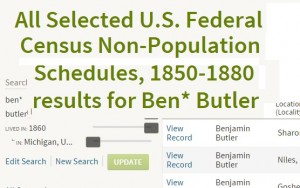 Readers of this blog are well aware of my difficulties in locating Benjamin Butler in several records, particularly the 1860 census. He’s been found in others:
Readers of this blog are well aware of my difficulties in locating Benjamin Butler in several records, particularly the 1860 census. He’s been found in others:
- 1850 in Port Huron, St. Clair, Michigan
- 1870 in Soap Creek Township, Davis, Iowa
- 1880 in Drywood, Vernon, Missouri
1860 remains a mystery.
Searches for Benjamin (using a variety of birth years, birth places, name variants, and location variants) in 1860 census indexes have been unsuccessful and will not be repeated in this post. Manual searches at this point have not been conducted, because there is good chance he was living in either:
- southern Michigan
- southern Iowa
- the northwestern two-thirds of Missouri
Or possibly elsewhere.
Then I remembered that there was one 1860 census I had not searched: the non-population schedules, particularly the agricultural one. Benjamin was not a manufacturer, but was a farmer in 1850 and 1880 and possibly one in 1860 as well. Using these schedules to find Benjamin is a good idea, with the following things kept in mind:
- the non-population agricultural census schedules only list the farmer and not family members
- these schedules do not include age or place of birth so I will only be searching by name and location.
- Benjamin may not have been a farmer in 1860
I have a list of Benjamin Bulters that I’ve located and eliminated as being mine. Keeping track of these “not-my-Benjamins,” along with the perceived reason for not being mine is an integral part of my research process. My hope is that the agricultural census index will locate a Benjamin Butler that I have not already seen in the 1860 census enumeration in one of the likely areas where Benjamin lived. I can then use that enumeration (and the specific location for this “farmer Benjamin”) to find this Benjamin Butler in the concomitant population schedule. The hope is that there is a Benjamin Butler in the population schedule whose enumeration is difficult to read but that whose agricultural schedule entry is legible.
No guarantees, but worth a try–as long as I keep the limitations of this approach in the forefront of my mind.

4 Responses
Using the agricultural census, back in the days before computers, was the way I found my g-grandfather in 1880. I had no index to the population schedule and the census film was very difficult to read; I was reading line-by-line, page by page and not seeing the family. Finding him and his neighbors in the agricultural census helped me locate them in the population schedule.
I can remember back in the 1980s when I was searching unindexed censuses page by page and the names were difficult to read that I looked at every German native in a certain township in an attempt to find the person in which I was actually interested.
Did he own or rent his farms? That’s a bit of moving around but even if renting, I would think that there might be some tax records around. Did he have partners?
In Michigan and Missouri he owned–I have the property and tax records. In Iowa it appears he either rented or (based upon the census) worked for the railroad. There’s also suggestions in some records that he lived in either Kansas or Nebraska (or both) during the 1850-1870 time frame as well. Part of the problem is that Benjamin just moved around quite a bit.